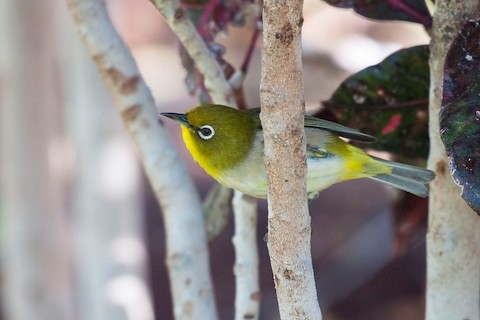Birdfinding.info ⇒ The Japanese form is common to abundant across most of its range—including Hawaii, where it has become the most ubiquitous songbird on the main islands. The “Mountain” form, resident of foothills and mountainous areas on many islands of the Philippines and Indonesia, is also common but localized.
Warbling White-eye
Zosterops japonicus
Family: Zosteropidae
East Asian islands from Sakhalin south to Indonesia.
Northern populations thrive in brushy woodlands of all kinds, from forests to urban gardens. Southern populations inhabit the same types of woodlands in the humid tropics, mostly at foothill elevations.
Peculiarly scattered across many archipelagos, comprising two sets of populations formerly classified under separate species, which have been reclassified based on studies of genetics, vocalizations, and other factors. The distinction is perhaps best preserved in part by regarding them as potentially distinct forms: “Japanese” and “Mountain” White-eyes (japonicus and montanus).
“Japanese White-eye”: six recognized subspecies that occur throughout the Japanese Archipelago and north onto southern Sakhalin, west to the southern Korean Peninsula and its adjacent islands, and south to the Ryukyu, Daito, Izu, and Ogasawara Islands.
Northerly breeding populations of Sakhalin, Hokkaido, and northern Honshu are migratory and withdraw to southern Japan for the winter.
Introduced populations are well-established on the main islands of Hawaii from Ni’ihau to the Big Island, where it is generally the most numerous songbird.
“Mountain White-eye”: nine recognized subspecies spread across the Philippines from Luzon to Palawan and Mindanao, and locally in several parts of Indonesia, including Sulawesi, the Moluccas, the Lesser Sundas, and highlands of Java and Sumatra.
Identification
A small, active, noisy songbird, mostly olive with the bold white-eyering typical of most Zosterops.
The upperparts are mostly olive-green, and the underparts are gray with a yellow throat and undertail coverts.
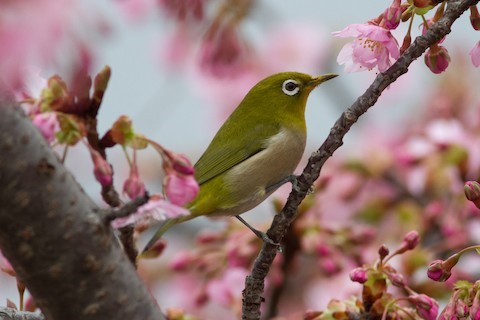
Warbling White-eye. (Ogura Reclamation Area, Kyoto, Honshu, Japan; February 25, 2020.) © Paul Hyde
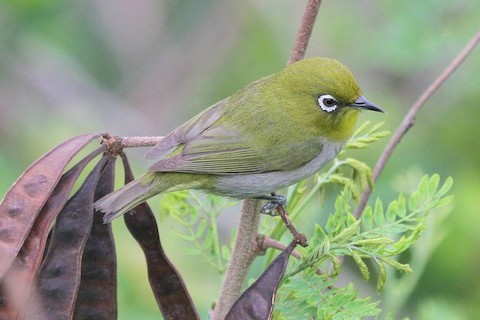
Warbling White-eye. (Kilauea Point National Wildlife Refuge, Kauai, Hawaii; February 28, 2018.) © John F. Gatchet

Warbling White-eye. (Waioli Park, Hanalei, Kauai, Hawaii; October 12, 2019.) © Doug Hommert
The brightness of the plumage varies somewhat among the many island races.
“Japanese White-eye” populations are generally duller, grayer, and darker overall.
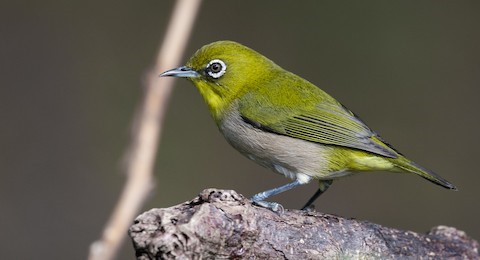
Warbling White-eye. (Kaanapali, Maui, Hawaii; December 20, 2019.) © Mason Maron
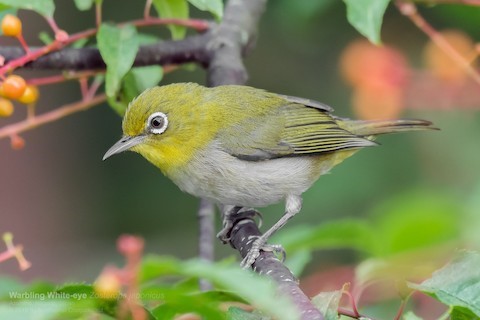
Warbling White-eye. (Karasugawa Valley Greenspace, Azumino, Nagano, Honshu, Japan; August 12, 2019.) © Natthaphat Chotjuckdikul
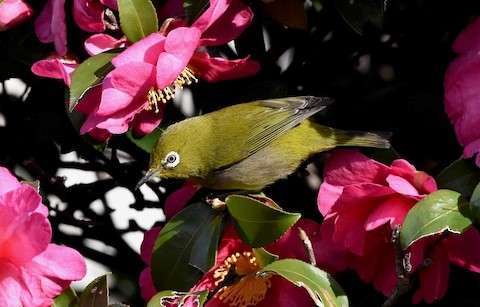
Warbling White-eye. (Imperial Palace, Tokyo, Japan; January 14, 2017.) © Lizabeth Southworth
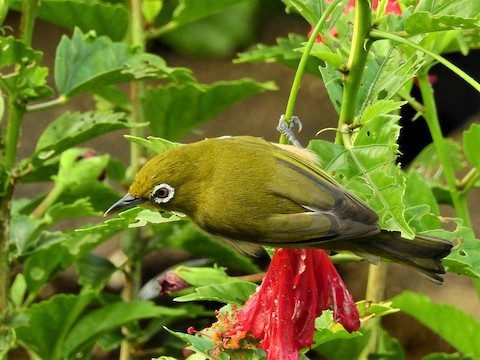
Warbling White-eye. (Kailua-Kona, Big Island, Hawaii; March 11, 2018.) © Bill Brynteson
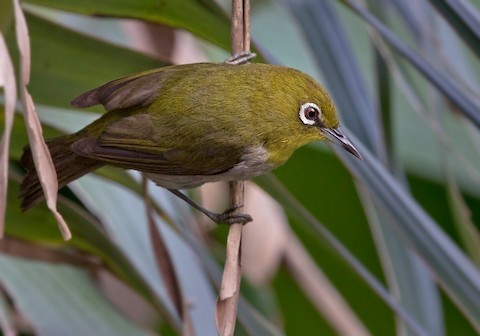
Warbling White-eye. (Haha-jima, Ogasawara Islands, Japan; May 27, 2017.) © Lars Petersson
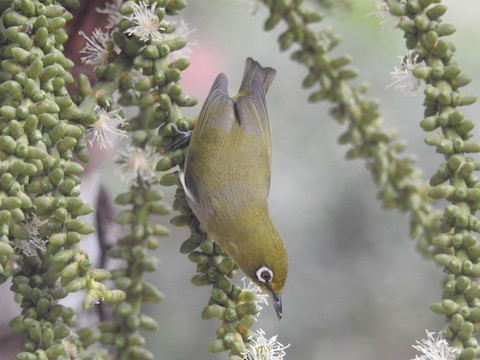
Warbling White-eye. (Makena State Park, Maui, Hawaii; November 12, 2017.) © Alan Barnard

Warbling White-eye. (Ogura Reclamation Area, Kyoto, Honshu, Japan; February 25, 2020.) © Paul Hyde

Warbling White-eye. (Kaloko Fishpond, Kaloko-Honokohau National Historic Park, Big Island, Hawaii; November 13, 2011.) © Ryan O’Donnell
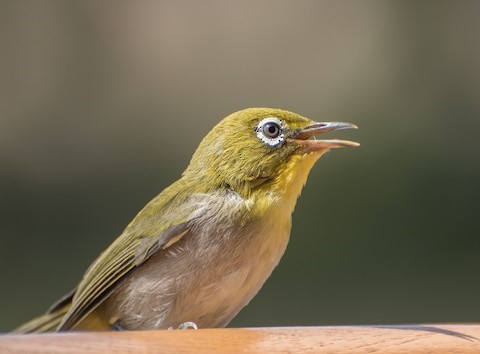
Warbling White-eye. (Ko Olina Golf Club, Oahu, Hawaii; May 14, 2017.) © Libby Burtner
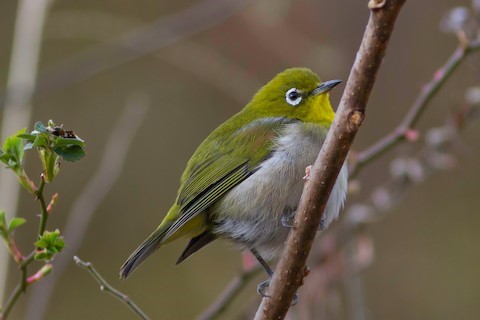
Warbling White-eye. (Higashiyama-Ku, Kyoto, Honshu, Japan; February 13, 2020.) © Paul Hyde
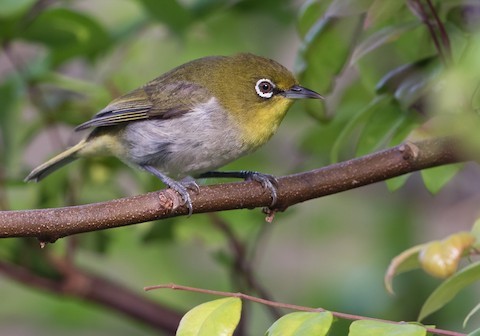
Warbling White-eye. (Haha-jima, Ogasawara Islands, Japan; May 27, 2017.) © Lars Petersson
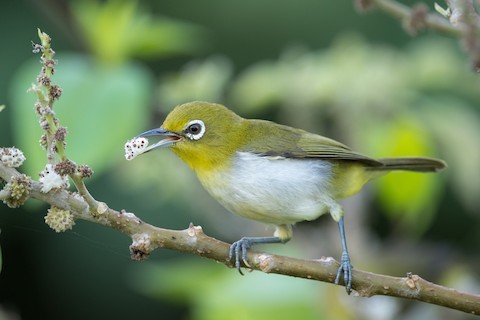
Warbling White-eye. (Ishigaki, Okinawa, Japan; June 20, 2020.) © Yann Muzika

Warbling White-eye. (Ishigakijima, Okinawa, Japan; May 23, 2017.) © Lars Petersson

Warbling White-eye. (Heuksan-do Island, Jeonranamdo, South Korea; October 29, 2011.) © Rémi Bigonneau
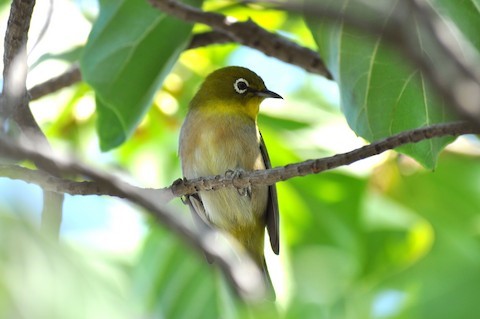
Warbling White-eye. (Kaloko Fishpond, Kaloko-Honokohau National Historic Park, Big Island, Hawaii; November 13, 2011.) © Ryan O’Donnell
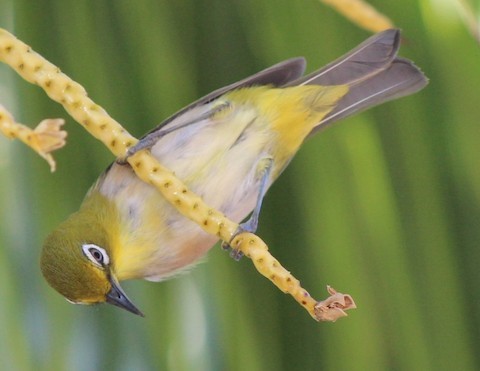
Warbling White-eye. (Kailua-Kona, Big Island, Hawaii; May 20, 2011.) © Magen Pettit

Warbling White-eye. (Hanalei National Wildlife Refuge, Kauai, Hawaii; February 1, 2018.) © Kevin Bauman

Warbling White-eye. (Tsukairaku Park, Mie, Honshu, Japan; September 14, 2017.) © Rick Folkening
“Mountain White-eye” populations are more vivid overall and typically have more yellow on the throat, extending up to the forehead and down to the chest—similar to Swinhoe’s White-eye (see below).

“Mountain White-eye,” Z. j. vulcani. (Eden, Davao City, Mindanao, Philippines; March 21, 2012.) © Matt Brady
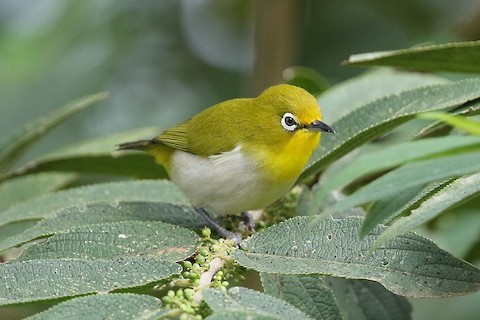
“Mountain White-eye,” Z. j. diuatae. (Compostela Valley, Mindanao, Philippines; March 22, 2018.) © Mark Sutton
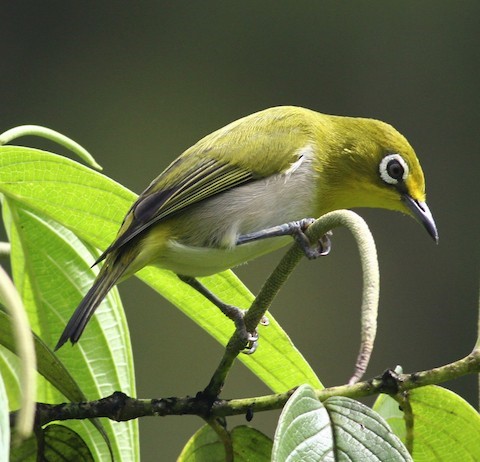
“Mountain White-eye,” Z. j. vulcani. (Mount Talomo, Davao City, Mindanao, Philippines; January 7, 2013.) © Paul Bourdin
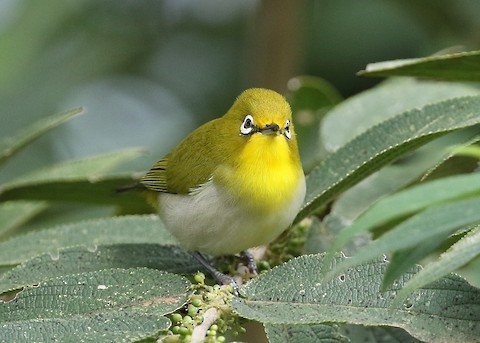
“Mountain White-eye,” Z. j. diuatae. (Compostela Valley, Mindanao, Philippines; March 22, 2018.) © Mark Sutton

“Mountain White-eye,” Z. j. vulcani. (Mount Kitanglad Range Natural Park, Mindanao, Philippines; March 1, 2011.) © Nick Athanas
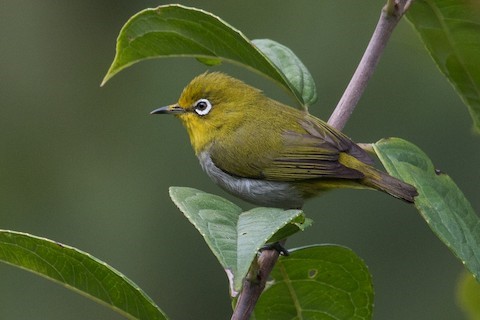
“Mountain White-eye,” Z. j. whiteheadi. (Mount Polis, Ifugao, Luzon, Philippines; April 4, 2017.) © Bradley Davis

“Mountain White-eye,” Z. j. vulcani. (Mount Talomo, Davao City, Mindanao, Philippines; April 15, 2018.) © Forest Jarvis
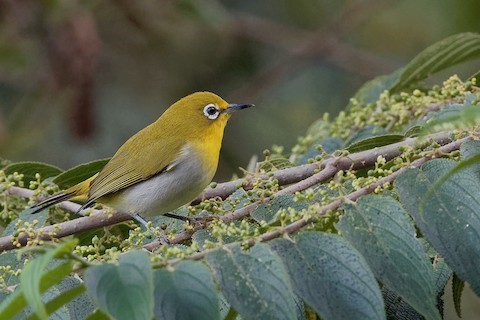
“Mountain White-eye,” Z. j. diuatae. (Compostela Valley, Mindanao, Philippines; March 8, 2019.) © Vincent Wang
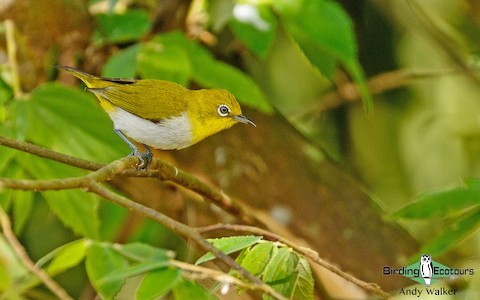
“Mountain White-eye,” Z. j. montanus. (Sulawesi Utara, Indonesia.) © Andy Walker, Birding Ecotours

“Mountain White-eye,” Z. j. obstinatus. (Maluku, Indonesia.) © Gil Ewing
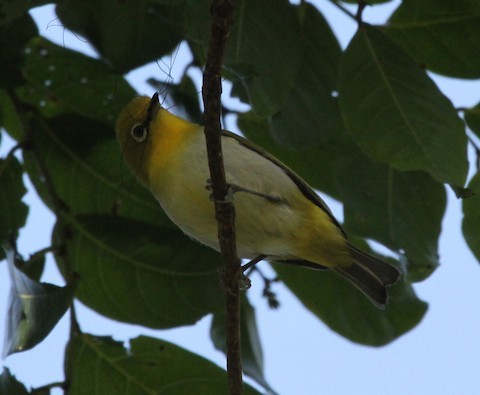
“Mountain White-eye,” Z. j. montanus. (Mundo Perdido, Timor-Leste; September 19, 2013.) © Colin Trainor
Cf. Swinhoe’s White-eye. Warbling and Swinhoe’s White-eyes together comprise about twenty similar-looking populations which have been classified variously under the formerly recognized species Japanese, Oriental, and Mountain White-eyes. The current classification is based largely on genetic analyses, and the races are identifiable mainly by location and voice. The northern populations of both species are migratory and their ranges approach closely enough that they likely occur together at least occasionally—especially in Taiwan, coastal China, and Korea.
The vocal differences between them seem consistent: Warbling has a harsher voice and choppier, chattery phrasing, whereas Swinhoe’s has a thinner, sweeter voice, and smoother, more relaxed delivery.
They also differ in appearance to some extent, but subtly and with significant overlap. Overall, the migratory populations now classified as Swinhoe’s (i.e., “Chinese”) are paler and more vividly colored than those classified as Warbling (i.e., “Japanese”). This distinction does not apply to the resident populations of the Philippines and Indonesia (i.e., “Williamson’s”, “Enggano”, and “Mountain”), which vary and seem to overlap widely in coloration.
“Chinese” (Swinhoe’s) tends to have yellow-olive upperparts and some yellow on the face that usually extends to the forehead, whereas “Japanese” (Warbling) has greenish-olive upperparts and yellow limited to the throat. Both “Chinese” and “Japanese” typically show a crisp boundary between the yellow throat and gray chest, but both sometimes have yellow that extends farther down onto the chest. The gray tones of the breast and also differ, at least on average, as “Japanese” often appears medium-gray or slightly brownish, whereas “Chinese” usually appears whitish-gray. (Note that both often show a faint yellowish wash on their gray underparts.)
Cf. Sangkar White-eye. Warbling (i.e., “Mountain”) and Sangkar White-eyes overlap widely and can appear similar—because Sangkar is highly variable and a minority resemble Warbling. In general, Sangkar differs in that it does not show clear color demarcations between gray and yellow on its underparts. Its underparts vary from all-yellow to mostly grayish, sometimes with a yellow center and gray sides, whereas Warbling has a gray breast and crisply defined yellow areas on the throat and undertail.
Cf. Lowland White-eye. Warbling (i.e., “Mountain”) and Lowland White-eyes are extremely similar and occur together on Luzon and other Philippine islands. Lowland tends to show somewhat more strongly contrasting yellow on the forehead and throat, and a harsher, deeper voice.
Notes
Polytypic species consisting of fifteen recognized subspecies, divided into two potentially distinct forms: “Japanese” (japonicus plus stejnegeri, insularis, loochooensis, alani, and daitoensis) and “Mountain” (montanus plus obstinatus, difficilis, parkesi, whiteheadi, diuatae, vulcani, pectoralis, and halconensis).
“Japanese” was formerly considered conspecific with Swinhoe’s White-eye (Z. simplex), known collectively as the Japanese White-eye (japonicus).
References
BirdLife International. 2019. Zosterops japonicus. The IUCN Red List of Threatened Species 2019: e.T155158005A155636070. https://dx.doi.org/10.2305/IUCN.UK.2019-3.RLTS.T155158005A155636070.en. (Accessed December 18, 2020.)
Brazil, M. 2009. Birds of East Asia. Princeton University Press.
eBird. 2020. eBird: An online database of bird distribution and abundance. Cornell Lab of Ornithology, Ithaca, N.Y. http://www.ebird.org. (Accessed December 18, 2020.)
Lim, B.T., K.R. Sadanandan, C. Dingle, Y.Y. Leung, D.M. Prawiradilaga, M. Irham, H. Ashari, J.G. Lee, and F.E. Rheindt, F.E. 2019. Molecular evidence suggests radical revision of species limits in the great speciator white-eye genus Zosterops. Journal of Ornithology 160:1-16.
Raine, H., and A.F. Raine. 2020. ABA Field Guide to the Birds of Hawai’i. Scott & Nix, Inc., New York.
Pratt, H.D., P.L. Bruner, and D.G. Berrett. 1987. A Field Guide to the Birds of Hawaii and the Tropical Pacific. Princeton University Press.
Pyle, R.L., and P. Pyle. 2017. The Birds of the Hawaiian Islands: Occurrence, History, Distribution, and Status. Version 2 (January 1, 2017). http://hbs.bishopmuseum.org/birds/rlp-monograph/. B.P. Bishop Museum, Honolulu, Hawaii.
Xeno-Canto. 2020. Warbling White-eye – Zosterops japonicus. https://www.xeno-canto.org/species/Zosterops-japonicus. (Accessed December 18, 2020.)
